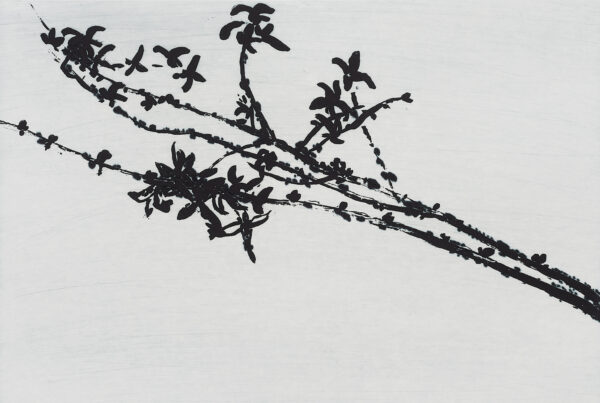깎아 들어가고, 붙여나가는
2024. 5. 1 - 6. 22 | [GALLERIES] ARARIO GALLERY SEOUL
문신, 권오상

Installation view_MOON Shin GWON Osang_Carving in Modeling out_ARARIO GALLERY SEOUL 1F
아라리오갤러리 서울은 2024년 5월 1일(수)부터 6월 22일(토)까지 조각가 문신(1922-1995)과 권오상(b. 1974)의 2인전 《깎아 들어가고, 붙여나가는(Carving in, Modeling out)》을 개최한다. 문신은 60년대 이후 한국 조각사에서 독창적이며 선구적인 매체적, 조형적 시도를 한 1세대 조각가로서, 권오상은 90년대 이후 사진을 이용한 가벼운 조각 등 새롭고 실험적인 작업을 선보인 동시대 조각가로서 인정 받아왔다. 본 전시에서는 문신의 70년대부터 90년대까지의 조각과 드로잉, 권오상의 근작 조각들 중 다양한 재료적, 형태적 실험이 두드러진 작품들을 선별해 선보임으로써 조각의 물질성과 공간성에 대한 두 작가의 태도를 살펴보고자 한다.

Installation view_MOON Shin GWON Osang_Carving in Modeling out_ARARIO GALLERY SEOUL B1F
이번 전시는 한국 조각사에서 독창적이며 선구적 시도로 인정받아온 조각가 문신의 1970년 이후부터 90년대까지의 다양한 시도들과 1990년대 후반 새로운 매체 실험으로 인정 받아온 후배 조각가 권오상의 조각적 실험들을 연결시켜보려는 시도이다.
전시는 시대별 나열을 통해 두 작가의 작업을 분리해 제시하는 방식이 아닌 주제별로 나뉜 3개의 전시 공간에서 층별로 자연스럽게 혼합하는 방식을 취했고, 이 방식을 통해 시대를 넘나들며 교류하는 두 조각가의 열정적인 실험 의지와 도전 정신들을 보여주는 데 주력한다. 나아가 권오상은 문신의 작품을 재해석하고 오마주한 작품을 이번 전시를 위해 특별히 제작해 소개한다는 점에서 단순히 두 조각가의 작업을 나열하는 데 멈추지 않고, 이들 작업 간 교류를 보여주고자 했다. 이들을 연결하게 된 가장 큰 계기는 형태 구축을 통한 조형 연구와 다양한 재료로의 실험이라는 공통 분모가 특별히 두드러지는 두 명의 조각가이기 때문이다.

문신 MOON Shin, 무제 Untitled, 1979, 브론즈 Bronze, 41 x 21 x 84.5(h) cm
화가에서 조각가로 전환했던 문신은 특정 형태나 이미지 표현보다 최소한의 조형 단위를 배치하고 구축하는 조형 방식에 천착했다. 그 결과물인 추상 조각들은 생명체를 연상시키는 아름다운 유기체적 형태를 갖거나 문신만의 내재적 리듬을 느낄 수 있는 특유의 곡선미가 두드러지는 독특한 형태로 귀결되었다. 특히 대칭과 비대칭이 미묘하게 공존하며 만드는 긴장감이나 정면성을 강조하는 형태, 그리고 완벽한 표면 처리는 문신 조각을 감상하는 묘미 중 하나다. 형태 구축에 대한 독특성뿐 아니라 보통의 캐스팅 방식보다는 철사나 금속 그물 등으로 기본 골조를 만들고 그 위에 더해진 석고를 갈고 조각하는 방식으로 형태를 만들어가는 방식이나, 덩어리로 된 통나무보다 제재된 납작한 목재로 형태를 다듬어 가는 등 끊임없이 선구적으로 다양한 재료와 제작 방식을 시도했다. 조각과 함께 중요하게 살필 문신의 드로잉은 대부분 조형의 가장 기본 형태인 원과 선이 연결되면서 확장되는 과정에서의 유기적 묘미들이 감각을 자극한다. 본 전시에서는 이러한 문신의 70년대 작품들과 함께 80년 후반부터 90년대를 아우르는 조각들을 주로 소개한다.

권오상 GWON Osang, Wind Hole Relief, 2024, 아카이벌 피그먼트 프린트, 혼합매체 Archival pigment print, mixed media, 29 x 5 x 37.5(h) cm
또 한 명의 작가 권오상은 90년대 후반 가벼운 조각을 표방하며 등장해 아이소핑크를 조각해 형태를 만든 뒤 사진을 부착하고 코팅을 더해 최종적 표면을 만들어내는 시리즈, 일명 사진 조각으로도 불리는 ‘데오도란트 타입’ 시리즈를 처음으로 시도했다. 권오상의 사진 조각은 조각의 정체성에 대한 물음과 그에 대한 명쾌한 시각적 대안의 제시였다는 점에서 첫 등장과 함께 관심을 받았고, 이후 지속해서 다양한 조형적, 기법적 연구를 선보여왔다. 이번 전시에서는 신작 추상 사진 조각들을 소개할 뿐 아니라, 기존 사진 조각을 확장해서 조각의 경계선에 서 있던 기존 사진 조각을 정통 조각 재료의 대표 격인 브론즈로 재해석한 작품을 와상과 두상의 형태로는 처음으로 선보인다. 더불어 또 하나의 확장 버전으로 기존의 입체적 사진 조각을 한 면이 강조된 부조로 표현한 작품이 다수 소개된다. 작가가 공기의 흐름이라고도 표현하는 조각의 구멍이 두드러지는 이 시리즈에서는 조각의 내부와 외부를 연결하면서 독특하고 다양한 공간감을 이끌어내고, 조각 안에서 또 하나의 작은 공간들을 만들어내는 조각에서의 구멍에 대한 작가의 사유가 담겨있다.

권오상 GWON Osang, Composition, 2024, 아카이벌 피그먼트 프린트, 혼합매체 Archival pigment print, mixed media, 86 x 50 x 72(h) cm
전시는 총 3개 층에서 진행된다. 지하 1층에서는 문신의 70년대 드로잉과 함께 80년대 후반과 90년대 제작된 흑단, 브론즈, 스테인리스 조각들과 함께 권오상의 신작 추상 사진 조각들, 이번 전시에서 최초로 선보이는 브론즈 와상과 두상 조각들이 서로 뒤섞여 다양한 재료와 기법 연구에 몰두한 두 작가의 시도를 집중적으로 보여준다. 1층에서는 문신 조각의 특징인 정면성을 잘 드러내며, 주변을 비추고 조각을 둘러싼 공간을 조각 내부로 끌어와서 품어내는 특징을 갖는 문신의 스테인리스 조각이 2점 설치된다. 여기에 이 전시에서 눈여겨볼 권오상의 조각 2점이 함께 설치되는 데, 그 중 하나는 문신의 조각 한 점을 확대 제작해 주변을 비추는 문신의 스테인리스 조각의 미학을 사진 조각으로 해석해 낸 작품이다. 더불어 권오상 작가의 조각에서의 구멍에 대한 사유를 담고 있는 5미터 대형 부조 사진 조각이 소개된다.

Installation view_MOON Shin GWON Osang_Carving in Modeling out_ARARIO GALLERY SEOUL 3F
마지막으로 3층에서는 문신이 60년대에 조각과 건축의 관계를 사유하며 고안한 ‘인간이 살 수 있는 조각’을 상상해 볼 수 있는 작품들이 소개된다. 현 창원문신시립미술관이 가장 적절한 예시이기도 한 인간이 살 수 있는 조각은 실제로 문신 조각에서는 많이 구현되지 않았고 드로잉으로 존재한다. 3층에서는 이 주제에 대한 문신의 초기 70년대 드로잉과 3점의 80-90년 조각이 설치된다. 권오상 또한 최근 인간이 사용할 수 있는 조각적인 가구 시리즈를 선보여왔고, 이 전시에서는 소파와 조명을 선보인다. 본 층에서는 주변 환경에 영향을 미치는 확장된 공간적 맥락에서의 해석을 요구하는 인간이 살 수 있는 조각에 대한 문신의 사유가 권오상에 의해 인간이 사용할 수 있는 조각으로 재해석되는 과정을 살펴볼 수 있다.
아라리오갤러리 서울
서울시 종로구 율곡로 85
02 541 5701
[GALLERIES] ARARIO GALLERY SEOUL
- Dates
- 2024. 5. 1 - 6. 22

![[2024 갤러리일호 신진작가공모전] 꿈과 마주치다展](https://static-edge.kiaf.org/web/2024/01/17191932/B-%EC%9D%B4%EB%8B%A4%EA%B2%BD-%EB%82%98%EC%9D%98-%ED%96%89%EB%B3%B5%EC%A7%80%EC%88%98%EB%8A%94-162.2x130.3cm-%EA%B4%91%EB%AA%A9%EC%97%90-%EC%9D%B4%EC%B1%84-%EC%88%98%EC%B1%84%EA%B3%BC%EC%8A%88-2023-300%EB%A7%8C-scaled.jpg)









